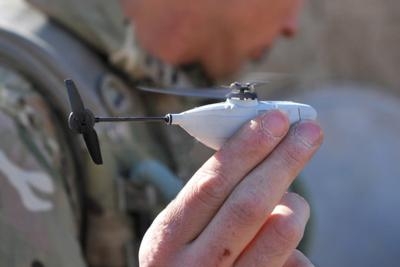Thu, Oct 31, 2013
'Black Hornet' Would Be Used For 'Personal Reconnaissance'
U.S. Army researchers are asking a Norwegian company to develop a pocket-sized helicopter drone to provide a personal reconnaissance unmanned aerial vehicle (UAV) for infantrymen and Special Forces warfighters. Officials of the Army Contracting Command in Natick, MA, are awarding a $2.5 million contract to Prox Dynamics AS of Nesbru, Norway, to develop the Black Hornet Personal Reconnaissance System (PRS) — a one-pound force-protection micro UAV for soldiers and small infantry units.

The Army Contracting Command is awarding the contract for the Black Hornet pocket unmanned aerial vehicle (UAV) on behalf of the Army Natick Soldier Systems Center as part of the Army Rapid Innovation Fund (RIF) for the transition of technologies developed by small businesses to solve immediate defense needs.
Prox Dynamics researchers will base the Black Hornet pocket UAV on the company’s PD-100 personal reconnaissance system, a mobile unmanned helicopter designed to provide infantry soldiers with immediate intelligence, surveillance, and reconnaissance (ISR) capability. The Prox Dynamics PD-100 PRS consists of the PD-100 nanocopter UAV and bas station. The entire package weighs less than two pounds, excluding display, and measures 8 by 3.5 by 2 inches.
The PD-100 micro UAV system is for applications such as search and rescue; reconnaissance in confined areas; look behind, between, and below obstacles; birds-eye view for situational awareness; object identification; proximity surveillance; crowd control; nuclear installation inspection; and checking chemical plants after incidents and accidents. The complete system fits inside a pocket; can be airborne within one minute; operates in confined areas and outdoors; is small and silent; requires little training and no pilot experience; represents no risks to other aircraft or personnel; and reusable or expendable, Prox Dynamics officials say.
The PD-100 UAV rotor diameter of less than five inches, weighs less than an ounce including camera, and flies as fast as 32 feet per minute on missions lasting as long as 25 minutes. The micro UAV has a digital data link with a range as far as 3,200 feet line of sight, GPS or visual navigation through video, autopilot with autonomous and directed modes, and can hover and stare, search patterns automatically, or fly preplanned routes.
The tiny helicopter UAV’s sensor payload has a steerable electro-optical camera with pan and tilt capability to provide live video and snapshot images.
The PD-100 base station provides mission planning, execution and analyses; display connections, functions and system controls; storage of mission data including video and images; and provides connections to PC, network, and other peripherals.
(Image provided by the U.K. MOD)
More News
During The Forced Landing, The Airplane’s Float Struts And Spreaderbars Collapsed Analysis: While en route to a remote fishing lodge in a float-equipped airplane, one of the >[...]
"X-59 is a symbol of American ingenuity. The American spirit knows no bounds. It's part of our DNA – the desire to go farther, faster, and even quieter than anyone has ever g>[...]
Aero Linx: The Honourable Company of Air Pilots The advancement of the public interest by the promotion of safety for all those who are employed in connection with or who travel by>[...]
Minimum Friction Level The friction level specified in AC 150/5320-12, Measurement, Construction, and Maintenance of Skid Resistant Airport Pavement Surfaces, that represents the m>[...]
Aero Linx: Aerospace Industries Association (AIA) For over 100 years, the American aerospace and defense industry has shaped the world around us. From the first flight to the moon >[...]
 NTSB Final Report: Dehavilland DHC-2 MK 1
NTSB Final Report: Dehavilland DHC-2 MK 1 Aero-News: Quote of the Day (10.29.25)
Aero-News: Quote of the Day (10.29.25) ANN's Daily Aero-Linx (10.29.25)
ANN's Daily Aero-Linx (10.29.25) ANN's Daily Aero-Term (10.30.25): Minimum Friction Level
ANN's Daily Aero-Term (10.30.25): Minimum Friction Level ANN's Daily Aero-Linx (10.30.25)
ANN's Daily Aero-Linx (10.30.25)



